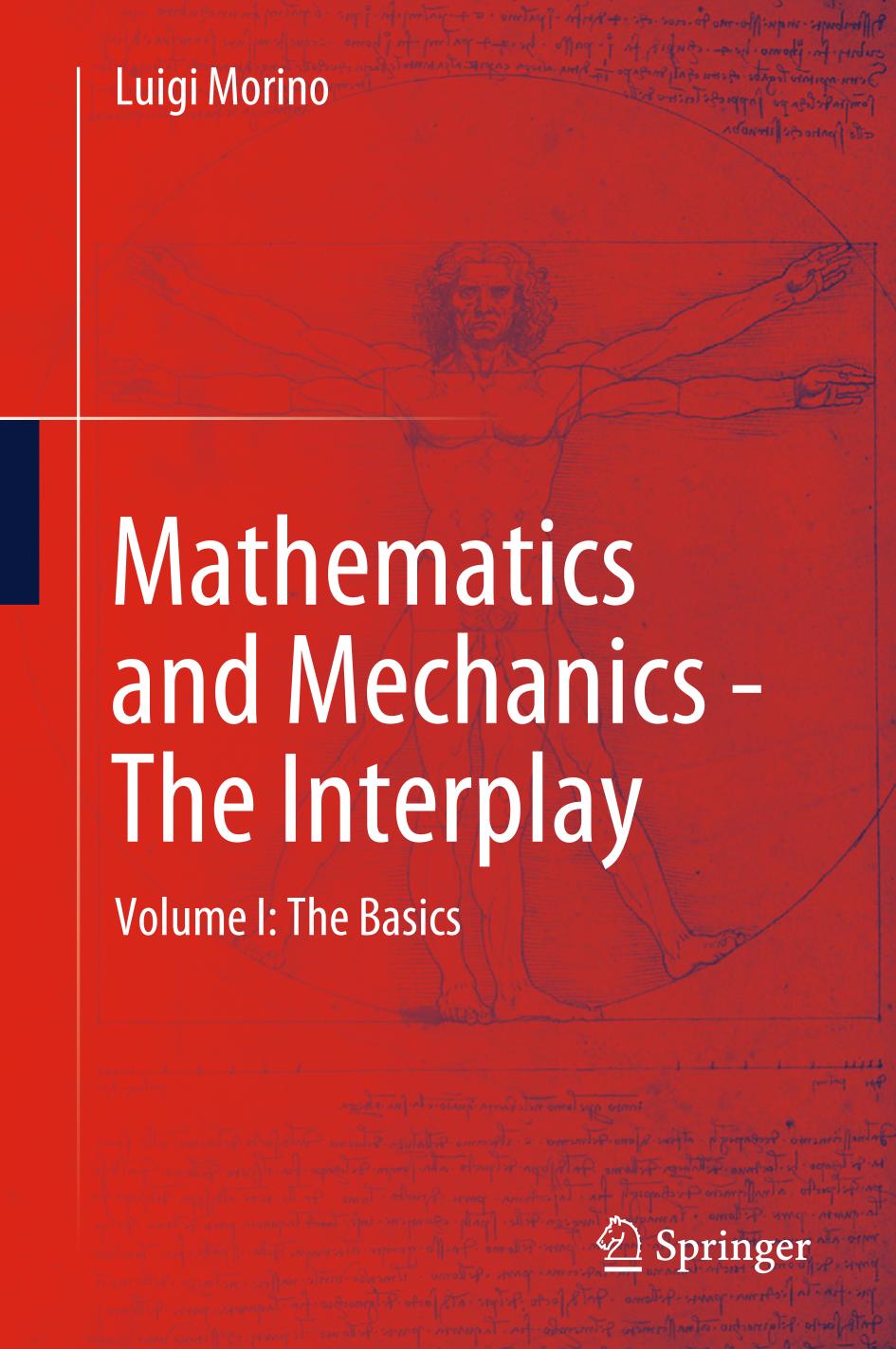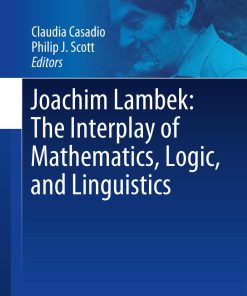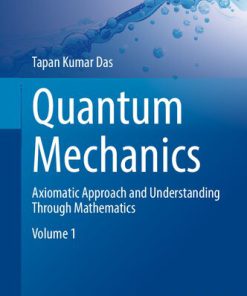Mathematics and Mechanics The Interplay 1st Edition by Luigi Morino ISBN 9783662632079 3662632071
$50.00 Original price was: $50.00.$25.00Current price is: $25.00.
Mathematics and Mechanics The Interplay 1st Edition by Luigi Morino – Ebook PDF Instant Download/Delivery: 9783662632079 ,3662632071
Full download Mathematics and Mechanics The Interplay 1st Edition after payment

Product details:
ISBN 10: 3662632071
ISBN 13: 9783662632079
Author: Luigi Morino
Mathematics and Mechanics The Interplay 1st Edition Table of contents:
Part I The beginning – Pre–calculus
Chapter 1 Back to high school — algebra revisited
1.1 Wanna learn math? Let’s talk bignè and babà
1.1.1 One equation with one unknown
1.1.2 Two equations with two unknowns
1.2 Where do we go from here?
1.2.1 Guidelines for reading this book
1.2.2 Axioms, theorems, and all that stuff
1.3 Natural numbers
1.3.1 Pierino. Arithmetic with natural numbers
1.3.2 Division of natural numbers
1.3.3 Fundamental theorem of arithmetic
1.3.4 Even and odd numbers
1.3.5 Greatest common divisor, least common multiple
1.4 Integers
1.4.1 Giorgetto and arithmetic with integers
1.5 Rational numbers
1.5.1 Arithmetic with rational numbers
1.5.2 The rationals are countable
1.5.3 Decimal representation of rationals
1.6 Real numbers
1.6.1 Irrational and real numbers
1.6.2 Inequalities
1.6.3 Bounded and unbounded intervals
1.6.4 Approximating irrationals with rationals
1.6.5 Arithmetic with real numbers
1.6.6 Real numbers are uncountable
1.6.7 Axiomatic formulation
1.7 Imaginary and complex numbers
1.7.1 Imaginary numbers
1.7.2 Complex numbers
1.8 Appendix. The Greek alphabet
Chapter 2 Systems of linear algebraic equations
2.1 Preliminary remarks
2.2 The 2 x 2 linear algebraic systems
2.2.1 Method by substitution
2.2.2 Gaussian elimination method
2.2.3 Summary
2.3 The 3 x 3 linear algebraic systems
2.3.1 Gaussian elimination for 3 x 3 systems
2.3.2 Illustrative examples
2.3.3 Another illustrative example; ∞^2 solutions
2.3.4 Interchanging equations and/or unknowns
2.3.5 Existence and uniqueness theorems
2.3.6 Explicit solution for a generic 3 x 3 system
2.4 The n x n linear algebraic systems
2.4.1 Gaussian elimination procedure
2.4.2 Details of the Gaussian elimination procedure
2.4.3 Existence and uniqueness theorems
Chapter 3 Matrices and vectors
3.1 Matrices
3.1.1 Column matrices and row matrices
3.1.2 Basic operations on matrices and vectors
3.2 Summation symbol. Linear combinations
3.2.1 Summation symbol. Kronecker delta
3.2.2 Linear combinations
3.3 Linear dependence of vectors and matrices
3.4 Additional operation on matrices
3.4.1 Product between two matrices
3.4.2 Products involving column and row matrices
3.4.3 Symmetric and antisymmetric matrices
3.4.4 The operation A:B
3.5 A x = b revisited. Rank of A
3.5.1 Linear independence and Gaussian elimination
3.5.2 Rank. Singular matrices
3.5.3 Linear dependence/independence of columns
3.5.4 Existence and uniqueness theorem for A x = 0
3.5.5 Existence and uniqueness theorem for A x = b
3.5.6 Positive definite matrices
3.5.7 A x = b, with A rectangular
3.6 Linearity and superposition theorems
3.6.1 Linearity of matrix–by–vector multiplication
3.6.2 Superposition in linear algebraic systems
3.7 Appendix A. Partitioned matrices
3.8 Appendix B. A tiny bit on determinants
3.8.1 Determinants of 2 x 2 matrices
3.8.2 Determinants of 3 x 3 matrices
3.9 Appendix C. Tridiagonal matrices
Chapter 4 Statics of particles in one dimension
4.1 Newton equilibrium law for single particles
4.1.1 Particles and material points
4.1.2 Forces
4.2 Equilibrium of systems of particles
4.2.1 The Newton third law of action and reaction
4.3 Longitudinal equilibrium of spring–particle chains
4.4 Spring–particle chains anchored at both ends
4.4.1 Chains of three particles
4.4.2 Chains of n particles
4.5 Particle chains anchored at one endpoint
4.6 Unanchored spring–particle chains
4.7 Appendix A. Inuence matrix
4.8 Appendix B. General spring{particle systems
4.8.1 The matrix K is positive definite/semidefinite
4.9 Appendix C. International System of Units (SI)
Chapter 5 Basic Euclidean geometry
5.1 Preliminaries
5.2 Circles, arclengths, angles and π
5.3 Secants, tangents and normals
5.4 Polygons
5.5 Triangles
5.5.1 Triangle postulate
5.5.2 Similar triangles
5.5.3 Congruent triangles
5.5.4 Isosceles triangles. Pons Asinorum
5.6 Quadrilaterals
5.6.1 Rectangles and squares
5.6.2 Parallelograms
5.6.3 Rhombuses
5.7 Areas
5.8 Pythagorean theorem
5.8.1 The Pythagorean theorem in three dimensions
5.8.2 Triangle inequality
5.9 Additional results
5.9.1 Three non–coaligned points and a circle
5.9.2 Easy way to find midpoint and normal of asegment
5.9.3 Circles and right triangles
Chapter 6 Real functions of a real variable
6.1 Introducing functions
6.1.1 Powers
6.1.2 Roots
6.1.3 Range and domain
6.1.4 The one–hundred meter dash
6.1.5 Even and odd functions
6.2 Linear independence of functions
6.2.1 Linear independence of 1, x and x^2
6.3 Polynomials
6.3.1 Zeroth–degree polynomials
6.3.2 First–degree polynomials
6.3.3 Second–degree polynomials. Quadratic equations
6.3.4 Polynomials of degree n
6.3.5 Linear independence of 1, x,… , x^n
6.4 Trigonometric functions
6.4.1 Sine, cosine and tangent
6.4.2 Properties of trigonometric functions
6.4.3 Bounds for π
6.4.4 An important inequality
6.4.5 Area of a circle
6.5 Exponentiation. The functions x^α and a^x
6.5.1 Exponentiation with natural exponent
6.5.2 Exponentiation with integer exponent
6.5.3 Exponentiation with rational exponent
6.5.4 Exponentiation with real exponents
6.5.5 The functions x^α and a^x, and then more
6.6 Composite and inverse functions
6.6.1 Graphs of inverse functions
6.7 Single–valued and multi–valued functions
6.8 Appendix. More on functions
6.8.1 Functions, mappings and operators
6.8.2 Functions vs vectors
Chapter 7 Basic analytic geometry
7.1 Cartesian frames
7.1.1 Changes of axes
7.2 Types of representations
7.2.1 Two dimensions
7.2.2 Three dimensions
7.3 Straight lines on a plane
7.3.1 Reconciling two de�nitions of straight lines
7.3.2 The 2 x 2 linear algebraic system revisited
7.4 Planes and straight lines in space
7.4.1 Planes in space
7.4.2 Straight lines in space
7.5 Circles and disks
7.5.1 Polar coordinates
7.5.2 Addition formulas for sine and cosine
7.5.3 Prosthaphaeresis formulas
7.5.4 Properties of triangles and circles
7.6 Spheres and balls
7.7 Conics: the basics
7.7.1 Ellipses
7.7.2 Parabolas
7.7.3 Hyperbolas
7.8 Conics. General and canonical representations
7.9 Conics. Polar representation
7.9.1 Ellipses
7.9.2 Parabolas
7.9.3 Hyperbolas
7.9.4 Summary
7.10 Appendix. “Why conic sections?”
Part II Calculus and dynamics of a particle in one dimension
Chapter 8 Limits. Continuity of functions
8.1 Paradox of Achilles and the tortoise
8.2 Sequences and limits
8.2.1 Monotonic sequences
8.2.2 Limits of important sequences
8.2.3 Fibonacci sequence. The golden ratio
8.2.4 The coast of Tuscany.
8.2.5 Principle of mathematical induction
8.3 Limits of functions
8.3.1 Rules for limits of functions
8.3.2 Important limits of functions
8.3.3 The O and o (“big O” and “little o”) notation
8.4 Continuous and discontinuous functions
8.4.1 Discontinuous functions
8.5 Properties of continuous functions
8.5.1 Successive subdivision procedure
8.5.2 Boundedness vs continuity
8.5.3 Supremum/infimum, maximum/minimum
8.5.4 Maxima and minima of continuous functions
8.5.5 Intermediate value properties
8.5.6 Uniform continuity
8.5.7 Piecewise–continuous functions
8.6 Contours and regions
8.6.1 Two dimensions
8.6.2 Three dimensions
8.6.3 Simply– and multiply–connected regions
8.7 Functions of two variables
8.7.1 Non–interchangeability of limits
8.7.2 Continuity for functions of two variables
8.7.3 Piecewise continuity for two variables
8.7.4 Boundedness for functions of two variables
8.7.5 Uniform continuity in two variables
8.8 Appendix. Bolzano–Weierstrass theorem
8.8.1 Accumulation points
8.8.2 Bolzano–Weierstrass theorem
8.8.3 Cauchy sequence
8.8.4 A rigorous proof of Theorem 73, p. 308
Chapter 9 Differential calculus
9.1 Derivative of a function
9.1.1 Differentiability implies continuity
9.1.2 Differentials. Leibniz notation
9.1.3 A historical note on infinitesimals
9.1.4 Basic rules for derivatives
9.1.5 Higher–order derivatives
9.1.6 Notations for time derivatives
9.2 Derivative of x^α
9.2.1 The case α = 0
9.2.2 The case α = n = 1, 2,…
9.2.3 The case α = –1
9.2.4 The case α = –2, –3,…
9.2.5 The case α = 1/q
9.2.6 The case α rational
9.2.7 The case α real
9.3 Additional algebraic derivatives
9.4 Derivatives of trigonometric and inverse functions
9.5 More topics on differentiable functions
9.5.1 Local maxima/minima of differentiable functions
9.5.2 Rolle theorem and mean value theorem
9.5.3 The l’Hôpital rule
9.5.4 Existence of discontinuous derivative
9.6 Partial derivatives
9.6.1 Multiple chain rule, total derivative
9.6.2 Second– and higher–order derivatives
9.6.3 Schwarz theorem on second mixed derivative
9.6.4 Partial derivatives for n variables
9.7 Appendix A. Curvature of the graph of f(x)
9.7.1 Convex and concave functions
9.7.2 Osculating circle. Osculating parabola
9.7.3 Curvature vs f”(x)
9.8 Appendix B. Linear operators. Linear mappings
9.8.1 Operators
9.8.2 Linear operators
9.8.3 Linear–operator equations
9.8.4 Uniqueness and superposition theorems
9.8.5 Linear mappings
9.9 Appendix C. Finite di�erence approximations
Chapter 10 Integral calculus
10.1 Integrals
10.1.1 Properties of integrals
10.1.2 Integrals of piecewise–continuous functions
10.2 Primitives
10.2.1 Primitives of elementary functions
10.3 Use of primitives to evaluate integrals
10.3.1 First fundamental theorem of calculus
10.3.2 Second fundamental theorem of calculus
10.4 Rules for evaluating integrals
10.4.1 Integration by substitution
10.4.2 Integration by parts
10.5 Applications of integrals and primitives
10.5.1 Separation of variables
10.5.2 Linear independence of sin x and cos x
10.5.3 Length of a line. Arclength
10.6 Derivative of an integral
10.6.1 The cases a = a(x) and b = b(x)
10.6.2 The case f = f(u; x); the Leibniz rule
10.6.3 General case: a = a(x), b = b(x), f = f(u; x)
10.7 Appendix A. Improper integrals
10.7.1 Improper integrals of the first kind
10.7.2 Improper integrals of the second kind
10.7.3 Riemann integrable functions
10.8 Appendix B. Darboux integral
Chapter 11 Rectilinear single–particle dynamics
11.1 Kinematics
11.1.1 Rectilinear motion, velocity and acceleration
11.1.2 The one–hundred meter dash again
11.1.3 What is a frame of reference?
11.2 The Newton second law in one dimension
11.2.1 What is an inertial frame of reference?
11.3 Momentum
11.4 A particle subject to no forces
11.4.1 The Newton first law in one dimension
11.5 A particle subject to a constant force
11.5.1 A particle subject only to gravity
11.6 Undamped harmonic oscillators. Free oscillations
11.6.1 Harmonic motions and sinusoidal functions
11.7 Undamped harmonic oscillators. Periodic forcing
11.7.1 Harmonic forcing with Ω ≠ ω
11.7.2 Harmonic forcing with Ω = ω. Resonance
11.7.3 Near resonance and beats (Ω ≅ ω)
11.7.4 Periodic, but not harmonic, forcing
11.7.5 An anecdote: “Irrational mechanics”
11.8 Undamped harmonic oscillators. Arbitrary forcing
11.9 Mechanical energy
11.9.1 Kinetic energy and work
11.9.2 Conservative forces and potential energy
11.9.3 A deeper look: U = U(x; t)
11.9.4 Conservation of mechanical energy
11.9.5 Illustrative examples
11.9.6 Minimum–energy theorem for statics
11.9.7 Dynamics solution via energy considerations
Chapter 12 Logarithms and exponentials
12.1 Natural logarithm
12.1.1 Properties of ln x
12.2 Exponential
12.2.1 Properties of exponential
12.3 Hyperbolic functions
12.4 Inverse hyperbolic functions
12.4.1 Derivatives of inverse hyperbolic functions
12.4.2 Explicit expressions
12.5 Primitives involving logarithm and exponentials
12.6 Appendix. Why “hyperbolic” functions?
12.6.1 What is u?
Chapter 13 Taylor polynomials
13.1 Polynomials of degree one. Tangent line
13.2 Polynomials of degree two; osculating parabola
13.3 Polynomials of degree n
13.4 Taylor polynomials of elementary functions
13.4.1 Algebraic functions
13.4.2 Binomial theorem
13.4.3 Trigonometric functions and their inverses
13.4.4 Logarithms, exponentials, and related functions
13.5 Lagrange form of Taylor polynomial remainder
13.6 Appendix A. On local maxima and minima again
13.7 Appendix B. Finite differences revisited
13.8 Appendix C. Linearization
Chapter 14 Damping and aerodynamic drag
14.1 Dampers. Damped harmonic oscillators
14.1.1 Dampers and dashpots
14.1.2 Modeling damped harmonic oscillators
14.2 Damped harmonic oscillator. Free oscillations
14.2.1 Small{damping solution
14.2.2 Large–damping solution
14.2.3 Critical–damping solution
14.2.4 Continuity of solution in terms of c
14.3 Damped harmonic oscillator. Harmonic forcing
14.4 Damped harmonic oscillator. Arbitrary forcing
14.5 Illustrative examples
14.5.1 Model of a car suspension system
14.5.2 Time to change the shocks of your car!
14.5.3 Other problems governed by same equations
14.6 Aerodynamic drag
14.6.1 Free fall of a body in the air
14.6.2 A deeper analysis. Upward initial velocity
14.7 Energy theorems in the presence of damping
14.8 Appendix A. Stability of x + px + qx = 0
14.9 Appendix B. Negligible–mass systems
14.9.1 The problem with no forcing
14.9.2 The problem with harmonic forcing
14.9.3 The problem with arbitrary forcing
Part III Multivariate calculus and mechanics in three dimensions
Chapter 15 Physicists’ vectors
15.1 Physicists’ vectors
15.1.1 Multiplication by scalar and addition
15.1.2 Linear independence of physicists’ vectors
15.1.3 Projections
15.1.4 Base vectors and components
15.2 Dot (or scalar) product
15.2.1 Projections vs components in R^3
15.2.2 Parallel{ and normal{vector decomposition
15.2.3 Applications
15.2.4 Dot product in terms of components
15.2.5 Lines and planes revisited
15.2.6 Tangent and normal to a curve on a plane
15.3 Cross (or vector) product
15.3.1 Cross product in terms of components
15.4 Composite products
15.4.1 Scalar triple product
15.4.2 Vector triple product
15.4.3 Another important vector product
15.5 Change of basis
15.6 Gram–Schmidt procedure for physicists’ vectors
15.7 Appendix. A property of parabolas
Chapter 16 Inverse matrices and bases
16.1 Zero, identity and diagonal matrices
16.1.1 The zero matrix
16.1.2 The identity matrix
16.1.3 Diagonal matrices
16.2 The inverse matrix
16.2.1 Definition and properties
16.2.2 The problem A X = B. Inverse matrix again
16.3 Bases and similar matrices
16.3.1 Linear vector spaces R^n and C^n and their bases
16.3.2 Similar matrices
16.3.3 Diagonalizable matrices
16.3.4 Eigenvalue problem in linear algebra
16.4 Orthogonality in R^n
16.4.1 Projections vs components in R^n
16.4.2 Orthogonal matrices in R^n
16.4.3 Orthogonal transformations
16.4.4 Gram{Schmidt procedure in R^n
16.5 Complex matrices
16.5.1 Orthonormality in C^n
16.5.2 Projections vs components in C^n
16.5.3 Hermitian matrices
16.5.4 Positive de�nite matrices in C^n
16.5.6 Gram{Schmidt procedure in C^n
16.6 Appendix A. Gauss–Jordan elimination
16.7 Appendix B. The L-U decomposition, and more
16.7.1 Triangular matrices. Nilpotent matrices
16.7.2 The L-U decomposition
16.7.3 Tridiagonal matrices
Chapter 17 Statics in three dimensions
17.1 Applied vectors and forces
17.2 Newton equilibrium law of a particle
17.2.1 Illustrative examples
17.3 Statics of n particles
17.3.1 General formulation
17.3.2 Statics of spring{connected particles
17.4 Chains of spring{connected particles
17.4.1 Exact formulation for spring–particle chains
17.4.2 Equilibrium in the stretched configuration
17.4.3 The loaded con�guration (planar case)
17.4.4 Linearized formulation (planar case)
17.5 Moment of a force
17.5.1 Properties of moments
17.6 Particle systems
17.6.1 The Newton third law
17.6.2 Resultant force
17.6.3 Resultant moment
17.6.4 Equipollent systems. Torques and wrenches
17.6.5 Considerations on constrained particle systems
17.7 Rigid systems. Rigid bodies
17.7.1 Levers and balance scales
17.7.2 Rigid system subject to weight. Barycenter
17.8 Appendix A. Friction
17.8.1 Static friction
17.8.2 Dynamic friction
17.9 Appendix B. Illustrative examples of friction
17.9.1 Pushing a tall stool
17.9.2 Ruler on two fingers
17.9.3 Particle on a slope with friction, no drag
17.9.4 Particle on a slope with friction and drag
Chapter 18 Multivariate differential calculus
18.1 Differential forms and exact differential forms
18.2 Lines in two and three dimensions revisited
18.2.1 Lines in two dimensions
18.2.2 Lines in three dimensions
18.3 Gradient, divergence, and curl
18.3.1 Gradient and directional derivative
18.3.2 Divergence
18.3.3 The Laplacian
18.3.4 Curl
18.3.5 Combinations of grad, div, and curl
18.3.6 The del operator, and more
18.4 Taylor polynomials in several variables
18.4.1 Taylor polynomials in two variables
18.4.2 Taylor polynomials for n > 2 variables
18.5 Maxima and minima for functions of n variables
18.5.1 Constrained problems. Lagrange multipliers
Chapter 19 Multivariate integral calculus
19.1 Line integrals in two dimensions
19.2 Path{independent line integrals
19.2.1 Simply connected regions
19.2.2 Multiply connected regions
19.3 Double integrals
19.3.1 Double integrals over rectangular regions
19.3.2 Darboux double integrals
19.3.3 Double integrals over arbitrary regions
19.4 Evaluation of double integrals by iterated integrals
19.5 Green theorem
19.5.1 Consequences of the Green theorem
19.5.2 Green theorem vs Gauss and Stokes theorems
19.5.3 Irrotational, lamellar, conservative, potential
19.5.4 Exact di�erential forms revisited
19.5.5 Integrating factor
19.6 Integrals in space
19.6.1 Line integrals in space
19.6.2 Surface integrals
19.6.3 Triple (or volume) integrals
19.6.4 Three{dimensional Gauss and Stokes theorems
19.7 Time derivative of volume integrals
19.8 Appendix. Integrals in curvilinear coordinates
19.8.1 Polar coordinates. Double integrals
19.8.2 Cylindrical coordinates. Volume integrals
19.8.3 Spherical coordinates. Volume integrals
19.8.4 Integration using general coordinates
19.8.5 Orthogonal curvilinear coordinates
19.8.6 Back to cylindrical and spherical coordinates
Chapter 20 Single particle dynamics in space
20.1 Velocity, acceleration and the Newton second law
20.2 Illustrative examples
20.2.1 Particle subject to no forces. Newton first law
20.2.2 Particle subject to a constant force
20.2.3 Sled on snowy slope with friction (no drag)
20.2.4 Sled on snowy slope with friction and drag
20.2.5 Newton gravitation and Kepler laws
20.3 Intrinsic velocity and acceleration components
20.3.1 A heavy particle on a frictionless wire
20.3.2 The circular pendulum
20.3.3 The Huygens isochronous pendulum
20.4 The d’Alembert principle of inertial forces
20.4.1 Illustrative example: a car on a turn
20.5 Angular momentum
20.5.1 Spherical pendulum
20.6 Energy
20.6.1 Energy equation
20.6.2 Potential vs conservative force fields
20.6.3 Potential energy for forces of interest
20.6.4 Minimum–energy theorem for a single particle
20.7 Dynamics solutions, via energy equation
20.7.1 A bead moving along a wire, again
20.7.2 Exact circular pendulum equation
20.8 Appendix A. Newton and the Kepler laws
20.8.1 Newton law of gravitation
20.8.2 Planets on circular orbits
20.8.3 The Kepler laws
20.8.4 Gravity vs gravitation
20.9 Appendix B. Cycloids, tautochrones, isochrones
20.9.1 Cycloids
20.9.2 Tautochrones
20.9.3 From cycloids to tautochrones
Chapter 21 Dynamics of n-particle systems
21.1 Dynamics of n-particle systems
21.2 Dynamics of mass{spring chains
21.2.1 Two–particle chain. Beats. Energy transfer
21.2.2 A more general problem
21.3 What comes next?
21.4 Momentum
21.4.1 Center of mass
21.5 Angular momentum
21.5.1 Useful expressions for angular momentum
21.6 Energy
21.6.1 Kinetic energy. The König theorem
21.6.2 Decomposition of the energy equation
21.6.3 Potential energy for two particles
21.6.4 Potential energy for fields of interest
21.7 Applications
21.7.1 How come cats always land on their feet?
21.7.2 Two masses connected by a spring
21.7.3 The Kepler laws revisited
21.8 Appendix A. Sun–Earth–Moon dynamics
21.9 Appendix B. Potential energy for n particles
21.9.1 Conservative external forces
21.9.2 Conservative internal forces
21.9.3 Energy conservation for conservative fields
Chapter 22 Dynamics in non–inertial frames
22.1 Frames in relative motion with a common point
22.2 Poisson formulas
22.2.1 Transport theorem
22.3 Frames of reference in arbitrary motion
22.3.1 Point of the moving frame
22.3.2 Point in the moving frame
22.4 Apparent inertial forces
22.4.1 Some qualitative examples
22.4.2 Gravity vs gravitation revisited
22.4.3 Mass on a spinning wire
22.4.4 A spinning mass–spring system
22.4.5 Spherical pendulum, again
22.4.6 Foucault pendulum
22.5 Inertial frames revisited
22.6 Appendix A. The tides
22.6.1 A relatively simple model
22.6.2 So! Is it the Sun, or is it the Moon?
22.6.3 Wrapping it up
22.7 Appendix B. Time derivative of rotation matrix
Chapter 23 Rigid bodies
23.1 Kinematics of rigid bodies
23.1.1 Instantaneous axis of rotation
23.2 Momentum and angular momentum equations
23.2.1 Momentum equation
23.2.2 Angular momentum equation
23.2.3 Euler equations for rigid–body dynamics
23.2.4 Principal axes of inertia
23.2.5 On the stability of frisbees and oval balls
23.3 Energy equation
23.3.1 Comments
23.4 Planar motion
23.4.1 Momentum and angular momentum equations
23.4.2 Energy equation
23.5 A disk rolling down a slope
23.5.1 Solution from P_0 to P_1
23.5.2 Solution from P_1 to P_2
23.5.3 Solution after P2
23.6 Pivoted bodies
23.6.1 Illustrative example: my toy gyroscope
23.7 Hinged bodies
23.7.1 Illustrative example: realistic circular pendulum
23.8 Appendix A. Moments of inertia
23.9 Appendix B. Tensors
23.9.1 Matrices vs tensors
23.9.2 Dyadic product. Dyadic tensor
23.9.3 Second–order tensors
23.9.4 Tensor–by–vector product
23.9.5 Tensors components and similar matrices
23.9.6 Transpose of a tensor
23.9.7 Symmetric and antisymmetric tensors
23.9.8 An interesting formula
References
Astronomical data
Index
People also search for Mathematics and Mechanics The Interplay 1st Edition:
luigi montoro math
mario and luigi playing the piano
mathematics and mechanics – the interplay
mario and luigi math
Tags:
Luigi Morino,Mathematics,Mechanics,Interplay
You may also like…
Engineering - Civil & Structural Engineering
Politics & Philosophy - Major Branches of Philosophical Study
Education Studies & Teaching - School Education & Teaching
Edexcel AS and A level Mathematics Statistics Mechanics Year 1 AS 1st Edition Greg Attwood
Politics & Philosophy - Social Sciences
Interplay 15th Edition by Ronald B Adler 9780197501351 0197501354
Education Studies & Teaching - School Education & Teaching
Edexcel AS and A Level Further Mathematics Further Mechanics. 2. 1st Edition Coll
Mathematics
Joachim Lambek The Interplay of Mathematics Logic and Linguistics 1st Edition Claudia Casadio
Education Studies & Teaching - Studying & Test Preparation
Politics & Philosophy - Major Branches of Philosophical Study
The Kantian Federation 1st Edition by Luigi Caranti ISBN 9781009016971 1009016970
Physics - Quantum Mechanics











